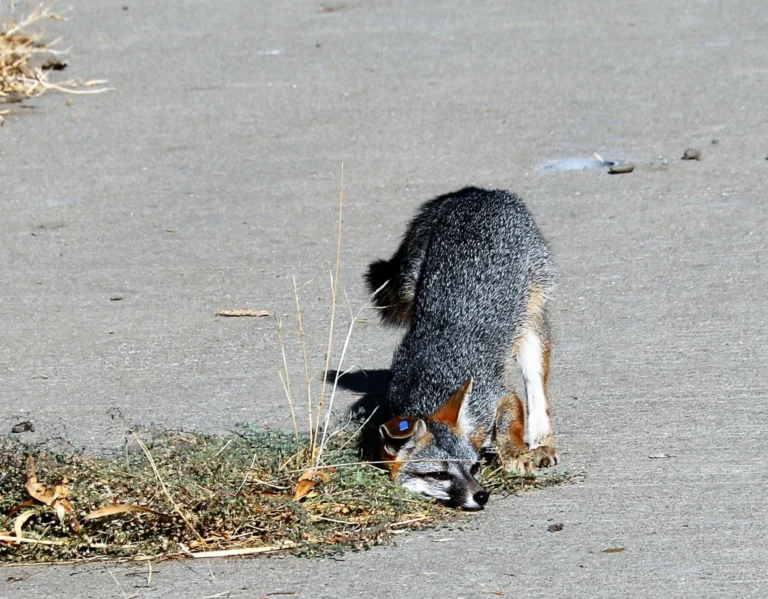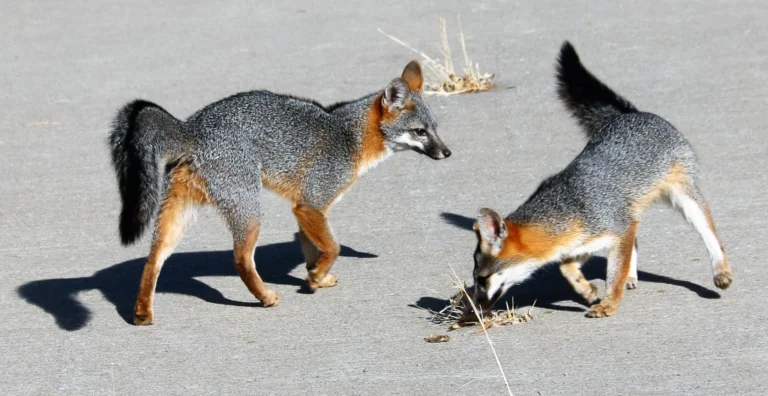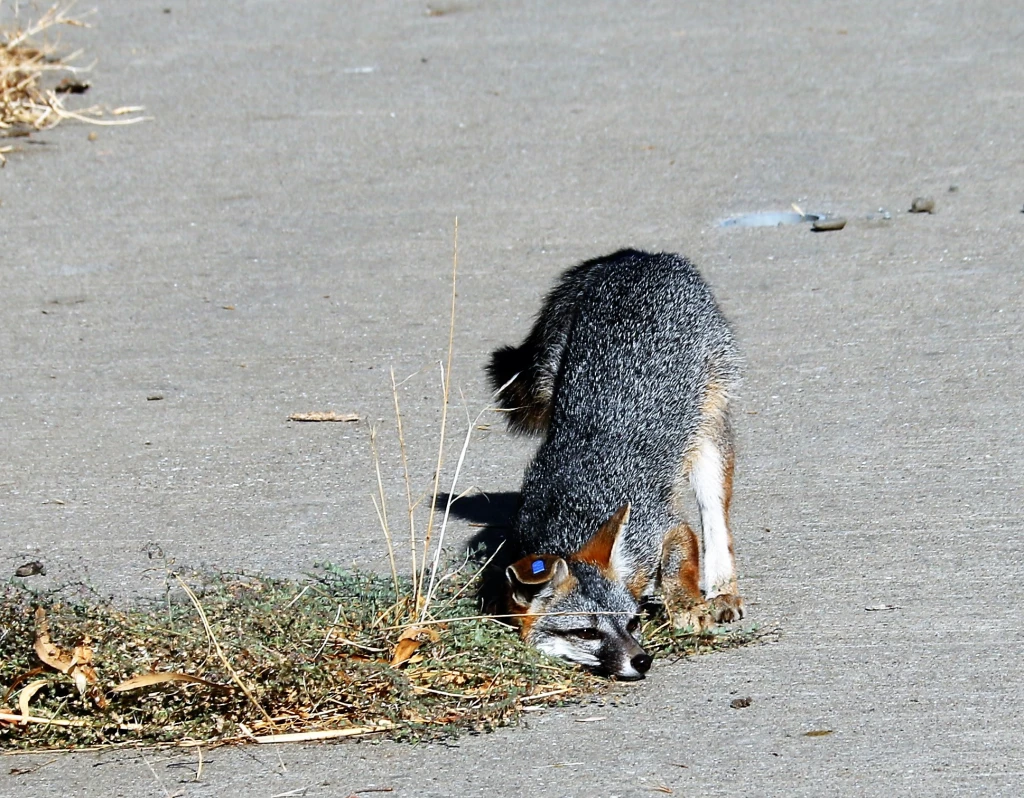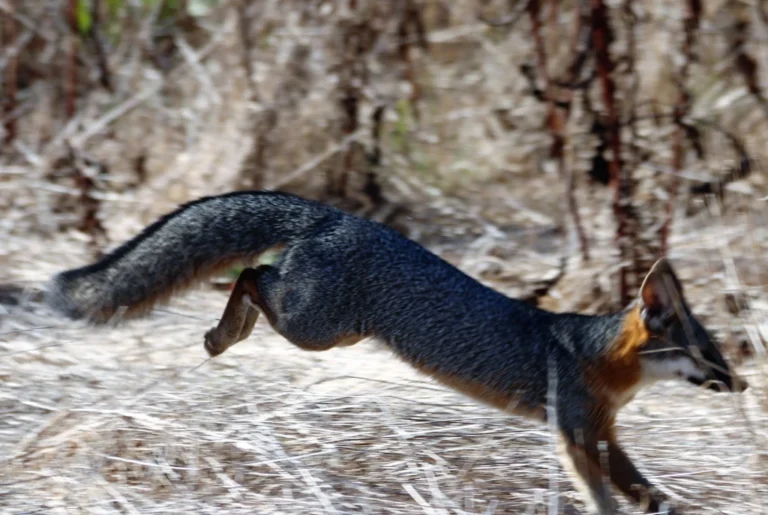Over the Course of this Year
by William C. Leikam
President, CEO & Co-founder, Urban Wildlife Research Project
When we began 2019, there were no foxes in the Palo Alto Baylands Nature Preserve. We had been waiting for the prior two years to see a fresh young pair appear, claim and repopulate the region with a litter of pups. As we neared the middle of January, I was becoming increasingly concerned that although we’d seen several gray foxes on our trail camera at Fox Hollow Gate, they just passed right on through the area without a pause. These foxes were on the move.
Early in January, I decided to post an additional trail camera in the overflow channel, because I had a hunch that when the baylands would be repopulated, the new foxes would most likely come in from over near the Moffett Field-Shoreline-Google Campus region. One of the canine distemper victims of 2016 had been ear tagged at Shoreline, so I knew that foxes had come from that direction. I put the camera in a location that prior to the die-out had seen consistent gray fox traffic.
On January 25th as I sat before my computer labeling the files from the night before, I slid the SD Card from camera #3 into the card reader, brought the files up and clicked on the first one. Stunned, along with a rippling excitement, I sat there watching a 30 second clip of a pair of gray foxes foraging in the rather tall grass. I shouted, “Yes, yes, yes! There they are.” I nearly cried with happiness. Two years and nearly one month of patiently waiting had paid off. Immediately, I knew that the repopulation had begun, but what I didn’t know was that this pair was about ready to show me something new in the behavior of the gray fox.

Throughout February and March, we kept a close eye on these two, especially the female that we came to call Big Eyes. I kept checking to see if she was pregnant. Well into March I had convinced myself that her sides bulged just as had other female foxes that I’d seen in year’s past. Big Eyes also did as others had, namely she became much more skittish and that added to my conclusion that Big Eyes was preparing to have their litter. April would be birthday.
April, May and June passed with no pups showing up before any of our trail cameras. On June 27th I left for my usual spring journey to Montana, to see my friend Bob and camp deep in the solitude of the wilderness high in the Rocky Mountains on the Spine of the Continent. In my absence, my field assistant Jessica kept the trail cameras on at night and she too closely checked for any sign of pups.
On July 15th I returned to my work at the baylands. Because Jessica had not seen any pups, I began having serious doubts that Big Eyes had given birth to a littler. I made it known that before I would actually conclude that there were pups, I needed to see and clearly identify the two adults and at least one other gray fox acting and looking rather pup-like. By the end of July, it became clear that Big Eyes and her mate Laimos had not had a litter, that she was one of those first-year females that “foregoes” having a litter until the second year. This was new to me, although I’d read research papers that pointed this out. On the other hand, it is possible that she may have had a pup or two that were stillborn. We’ll never know.

By the first part of August we began noticing a young-looking gray fox trotting past the trail cameras. This was not a pup. This was an interloper, a trespasser into the pair’s home range. This fox was fitted with a blue tag, number V-1. At first I thought that it was a yearling but as I saw more video of this fox, I realized that this was a female and she had the tip of one ear missing as well as three notches along the edge of her left ear. These were indicators that she was older than first estimated because notches and a missing piece of a fox’s ear means that she’s been in numerous major battles along the way. She was probably two, maybe three years old.
And more fights were just around the corner. Although we hadn’t yet seen an actual fight, the physical stances that the pair of foxes took when they encountered each other: ears flat back on her head, tail notched, legs extended, suggested a high degree of alertness and they showed all the signs of being ready to forcefully remove this little trespasser from their home range.
One afternoon after I had set up camera #7 and left the area, Flop trotted right toward the trail camera. She veered off to her right and off camera, when suddenly, seemingly from nowhere, female Big Eyes dashed across to where Flop had gone. Off camera the screaming, the sharp, cracking shrieks of a fox fight filled the air. Within seven seconds, and that’s a long fight, everything stopped. Flop came out in front of the trail camera and stood there. Down along the trail Big Eyes emerged. They squared off but instead of Flop resuming her fight stance, she casually walked back to where she had been off to her right, my left. Big Eyes didn’t follow but trotted off toward the creek. That was but one of numerous fights between the pair and Flop.
That must have been frustrating for Big Eyes and her mate Laimos for no matter what she and he did, Flop would not allow them to drive her out. Around the first part of November I didn’t see Flop either live or on any cameras. I told my new field assistant Johanna that I thought that Flop had left. On November 15, two local biologists working nearly three miles from our study area, live-trapped a female gray fox with a blue ear tag V-1. Flop had returned to her territory near Shoreline. It felt good to know that she was healthy and alive.
By December 2019 and throughout that month, there was nothing noteworthy to report. We’ll see how the pair Laimos and Big Eyes fare during this coming year 2020. We are hoping for pups to be born in April so that we can launch a multi-year collaring campaign that will increase the health of the local habitats and the wildlife. More on that during upcoming Gray Fox Reports.
Section III
Gray Fox, Baylands Goals
Within the permit that allows the Urban Wildlife Research Project to conduct its study of the behavior of the gray fox at the Palo Alto Baylands Nature Preserve, the objectives covered area:
- Monitoring of urban gray fox Denning sites in Palo Alto Baylands.
This is being accomplished during the period when the gray foxes use a den site. It is one of the prime locations for gathering most of the behavioral data of the litter and for adults alike.
- Assessment of status and population trends of Baylands urban gray foxes
Since January 2019 a pair of resident gray foxes have claimed territory at the Palo Alto Baylands Nature Preserve.
- Identification of habitat features that promote the presence of urban gray foxes
After considering this and talking with people who know how to restore habitats, we need to assess what kinds of plants, including the Alkaline Salt Bush, would grow best along the edge of the saltwater channel and alongside the marsh. We need to grow a permanent habitat that contains the corridors and plant it as soon as possible. We’ll keep an eye on this as this is a critical link between the southern region of the Baylands and the northern region.
- Assessment of reproductive success and identification of factors that promote successful reproduction
Open up the pinch-point along Matadero Creek by developing thickets that link one area to another, instead of the present “islands”.
- Identification and assessment of possible dispersal travel routes.
Presently there can only be guesses as to dispersal travel routes. We intend to make this important question much more concrete when we attain our collaring/take/capture permit from the Department of Fish & Wildlife.





